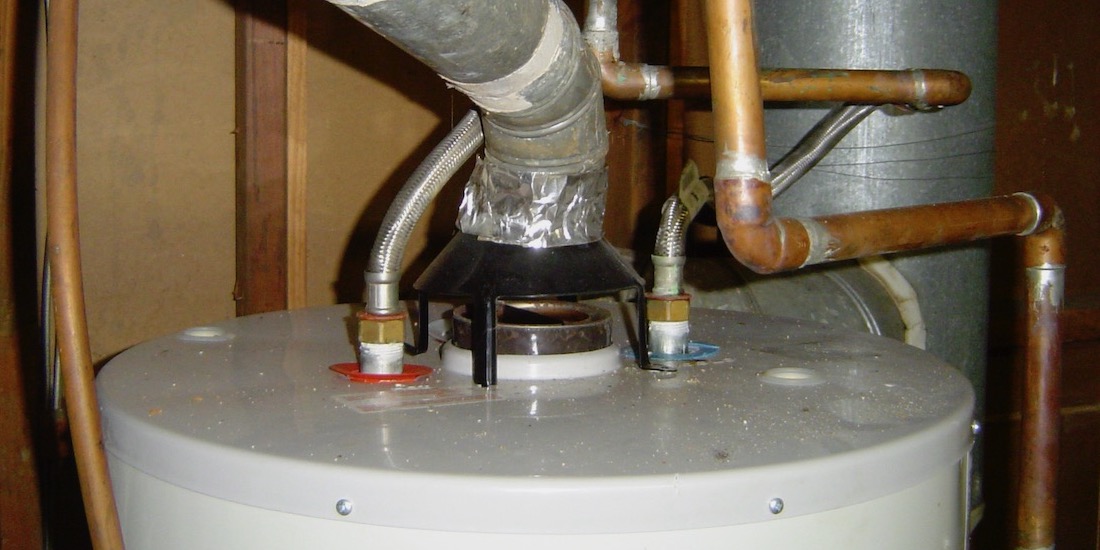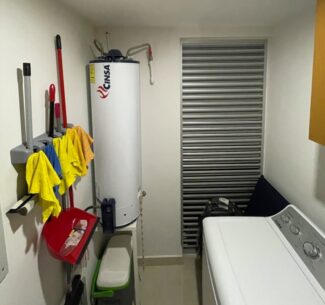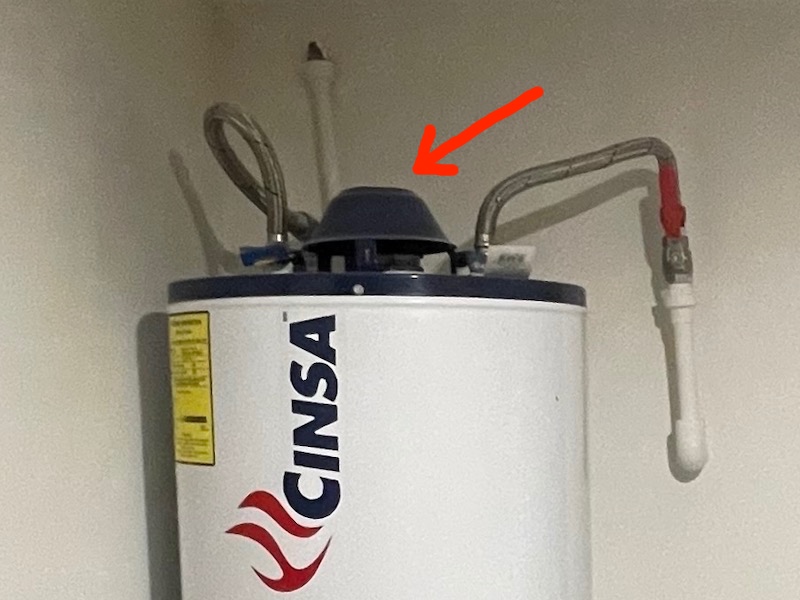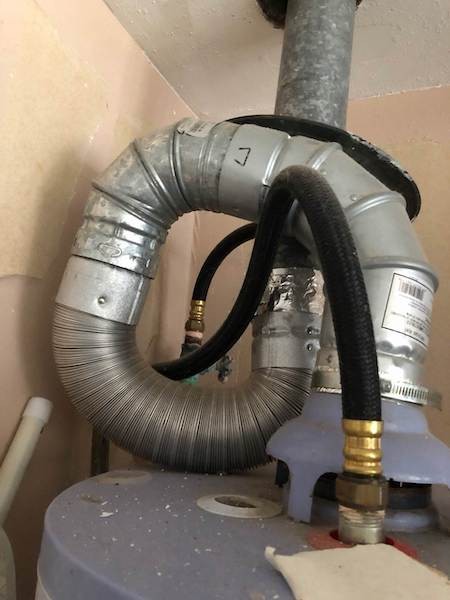A Dangerous Gas Water Heater Hidden in Plain View

My friends Elena Chrimat and Alex Williams* recently went on vacation in Mexico. They booked a condo and traveled down there from their home in the Phoenix, Arizona area. They may the first ones ever to stay there who looked at the laundry (photo below) and had an immediate concern. Do you see why this is a dangerous gas water heater?

A hidden danger
The problem with the water heater is easy to spot if you know what to look for. First, it’s easy to identify it as a gas water heater. There’s a gas line going to the regulator at the bottom of the water heater and a draft diverter—the conical piece—at the top of the water heater (photo below). So it heats water by burning fossil gas, which is mostly methane.

This type of water heater is called a “natural draft” water heater because it removes the exhaust gases without assistance by a fan. The buoyancy of the hot gases causes them to rise. The flue channels them to an exterior vent up and away from the living space. The lead photo at the top of this article shows a natural draft water heater with a flue attached to the draft diverter.
This condo has no flue. All of the exhaust gases empty into that laundry room. The designers or installers or both decided to cut the cost of running flues through this 27 story building by just putting in those louvers you see on the right. On the other side is an exterior hallway open to the outdoors.
Are louvers enough?
Relying on that louvered opening to remove the exhaust gases is a dangerous proposition, for more than one reason. First, hot exhaust gases rise. When they come out of the top of the water heater, they’re going straight to the ceiling above. From there, they’ll spread out in every direction. Some may escape through the upper louvers.
If there’s pressure in the hallway on the other side of the louvers has a lower pressure than the laundry room, more of the exhaust gases will go out. I suspect, though, that when that dangerous gas water heater operates, a lot of the exhaust gases will hang out in that room for a while. One way to remove them more quickly would be to run the dryer, but doing that whenever the water heater is on would be difficult.
Second, if the exhaust gases do what the designers hoped, that hallway fills with carbon dioxide, nitrogen dioxide, water vapor, and maybe some carbon monoxide, too. And it would be coming from every unit with a water heater that’s heating water. Alex told me that the hallway is open to the outdoors on one end, so anyone walking through may breathe in quite a bit of nasty air.
Elena and Alex are home performance contractors in Phoenix (check out their company: Ideal Energy), so they understand combustion safety. They knew immediately that the water heater could put carbon monoxide into the air. They saw the louvered opening as a possible exit path for the exhaust gases but knew they could still be in danger. Fortunately, the laundry room has a door, and they left it closed when they were in the condo. They also had a large sliding door that they left open for fresh air.
Did they suffer low-level carbon monoxide poisoning on their vacation? It’s hard to know. They didn’t bring a CO monitor so they don’t know for sure. Also, when gas combustion is working as it should, it produces little to no carbon monoxide. But other combustion products (nitrogen dioxide and carbon dioxide) can be a problem, too. While there, they spoke with someone who lived in the building, and he has a Nest carbon monoxide detector…which he said has gone off a few times.
If you’re wondering how this unvented gas water heater is different from a ventless gas fireplace, it isn’t. They’re also a hazard, which is why they’re banned in Canada and other places. The ventless gas fireplace industry has been fighting the ASHRAE residential ventilation committee for a while, and they’re doing their best to keep from being banned completely. Here’s an update on that battle from 2016. In 2018, the last time I attended one of the meetings, things were still about the same. A friend on the committee tells me they’ve just introduced a proposal to ban ventless gas fireplaces completely, and it looks like it’s going to pass.
Beware of dangerous gas water heaters
Leaving the flue off of a gas water heater may seem like a situation you won’t encounter in the US, but don’t be so sure about your safety. Plenty of natural draft gas water heaters in the US are dangerous. They’re the most easily backdrafted combustion appliances found in homes. And a lot of homes have them.

You can do a quick check to make sure your flue goes up all the way to the outside. And while you’re inspecting for rise, also look for disconnects in the flue. That’s another common problem. Also, if you have any combustion appliances appliances in your house (or an attached garage), get yourself a low-level carbon monoxide monitor.**
Those of us who know a little building science walk into buildings and immediately check out this kind of stuff. We can’t not do it. Most of the time, the bad stuff we see hurts energy efficiency, comfort, or durability. As you can see from Alex and Elena’s experience, though, sometimes we find buildings that can be dangerous. It’s good to know a little building science in those cases.
Allison Bailes of Atlanta, Georgia, is a speaker, writer, building science consultant, and founder of Energy Vanguard. He is also the author of the Energy Vanguard Blog and is writing a book. You can follow him on Twitter at @EnergyVanguard.
* Elena and Alex have a home performance contracting company in Phoenix, Arizona called Ideal Energy. If you’re lucky enough to live in their service are, you shouldn’t hesitate to hire them when you need home performance work done on your house.
** This is a TruTech Tools affiliate link. You pay the same price you would pay normally, but Energy Vanguard may make a small commission if you buy after using the link.
Related Articles
Combustion Safety 101: Three Types of Problems
The Problem of Getting Air for Atmospheric Combustion Appliances
Unvented Natural Gas Space Heaters Should Be Removed
A Ventless Gas Fireplace Is a Liability
NOTE: Comments are moderated. Your comment will not appear below until approved.
This Post Has 16 Comments
Comments are closed.

> If you’re wondering how this unvented gas water heater is different from a ventless gas fireplace, it isn’t.
Is it also the same as a gas range with a recirculating range hood? I think it might be time to drop the gas when we need to replace our appliances.
On Friday I was reminded of this after working outside all afternoon: I came inside and could immediately smell that the range was on. Not a food smell and not an unburnt natural gas smell, but it had a definite combustion-ey nature to it. I probably don’t notice the smell as much when I am inside when we start the burners: boiling frog analogy and all that.
Paul, yes, it’s similar. A recirculating hood can remove some of the stuff from the exhaust, but it depends on the type of filter and how recently it’s been replaced. Ventless gas fireplaces are worse, though, because they dump all of their exhaust gases into the home.
Does this application agree with the manufacturer’s intentions in Mexico?
Everyone who occupies that dwelling is in danger of exponentially increasing the production of carbon monoxide every time that space is closed off. You mentioned that CO, oxides of nitrogen and moisture will be present when it operates–the biggest danger is the depression of the oxygen content of the space. Under the right conditions someone entering that laundry room could be overcome in less than 60 seconds.
With reference to the second photo these things happen all the time. I once had someone move the hot water heater from the center of the basement where it connected to the chimney to the outer wall directly next to the dryer. From there it was vented downward; and was joined in common with the fully functional dryer vent and dryer!
During an inspection I realized that I could not see the chimney penetration through the roof. When I entered the attic I recognized the presence of combustion gas. I discovered that the furnace and water heater in the basement were correctly vented using B-Vent; however the B-Vent was never run past the insulation in the attic. We were hired to complete the venting and provide the required roof flashing.
Mike, my guess is that the answer to your question is no.
Yeah, I’ve seen some bad installations of combustion appliance venting myself and even more photos. It’s definitely a problem.
The loopty loop vent water heater also appears to have nonmetallic hoses, that’s another code issue. And first photo has duct tape and a less than 45degree rise vent. Not sure if the duct tape is a code issue but definitely not good practice. The last three home purchases I checked for family members all had the red and blue plastic rings melted , another sign of back drafting. The hired home inspectors weren’t concerned.
Lee, the closer you look at the photos, the more problems you’ll find. On the amount of rise required, though, the code (NFPA 54) says all that’s needed is 1/4″ per foot, not 45 degrees.
Hi Allison,
I believe this water heater is more dangerous than described. You stated that “. . . when gas combustion is working as it should, it produces little to no carbon monoxide.” There is no way that this gas combustion appliance is working “as it should” because it is not connected to a vent/flue/chimney. The vent does more than transport combustion products safely out of the living space; it also provides the draft that pulls the air through the appliance. Natural draft combustion appliances are designed to operate with a certain amount of draft (negative pressure), and there are tables that provide the minimum size and height of these vents to ensure the necessary draft is produced A natural draft water heater such as this one with no vent whatsoever will pull less air through the combustion process than it should, resulting in incomplete combustion and high concentrations of CO being produced.
It has now been quite a few years since the good folks (and great building scientists) up in Minneapolis first discovered that some water heaters working perfectly and producing zero ppm would all of a sudden begin producing tons of CO when backdrafted. Why? The backdrafting essentially removed the chimney from the equation; instead of lots of draft these water heaters now had almost none, resulting in too little oxygen for the combustion process and lots of CO being produced, just as the one discussed here is probably doing.
Not sure what the law/code is there in Mexico but finding something like this in the U.S. would, I believe, require a “red tag” and taking the water heater out of service.
Bill, excellent point. Incomplete combustion occurs when there’s not enough oxygen and that requires enough air movement through the burner.
We lived in a house in Vermont that had a propane water heater when we bought it that we immediately replaced with electric. The water heater was in a very small (8×5) laundry room. The window is closed during the winter.
Here was my thinking: You run a load of warm or hot laundry. This kicks on the water heater, which takes a while. In the mean time, you put the laundry in the drier, and if you don’t like noise, you close the door to the small room. Now the drier is back drafting the water heater into the small laundry room! We know with 100% certainty that there had been an electric water heater before the gas one.
The person who installed the gas one did not consider the back drafting consequences of putting it into a very small room with a drier. Who knows how often the previous owners were exposed to carbon monoxide because of that.
Bob, the only good thing about that scenario is that with the dryer running and backdrafting the water heater, most of the exhaust gases and carbon monoxide would get exhausted through the dryer. But as soon as the dryer goes off, exhaust gases will collect in the room if the water heater were still operating. What could make it worse is if you had leaky return ducts in there to pull in the CO and distribute it to the bedrooms.
Unvented gas-fired appliances of any kind are lunacy. I am a 40 year class “A” gas-fitter and have seen too many dead people taken out of their homes feet-first due to carbon monoxide poisoning (their HOMES, where they should be SAFEST)! A lack of a little O2 – a little lack of a way to get toxic flue products out of the living space, and a normally well behaved appliance becomes LETHAL! ☠️
Not being dramatic here folks – the numbers are there.
Roy Collver
Roy, I totally agree that unvented gas appliances are lunacy.
Many safety authorities in many jurisdictions have archived accident reports for fatality and near-fatality incidents on-line these days. It sometimes takes a bit of effort to find them – but they make for grim reflection. These resources should be mandatory reading for engineers, inspection persons, suppliers and tradespeople – anyone who works with combustion appliances.
Is there a T & P device on this water heater?
Albert, I don’t know. That pipe on the wall behind the water may be it.
The water heater is also not strapped in – which is the first thing I saw in the picture. ANd it’s elevated to make it easier to fall & fall further. My vague understanding is Mexico is on a fault line and is likely more susceptible to earthquakes than where I live.